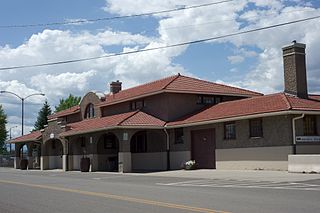
The Denver & Rio Grande Western Railroad, often shortened to Rio Grande, D&RG or D&RGW, formerly the Denver & Rio Grande Railroad, was an American Class I railroad company. The railroad started as a 3 ft narrow-gauge line running south from Denver, Colorado in 1870. It served mainly as a transcontinental bridge line between Denver, and Salt Lake City, Utah. The Rio Grande was also a major origin of coal and mineral traffic.

The Prospector was a passenger train operated by the Denver & Rio Grande Western railroad between Denver, Colorado and Salt Lake City, Utah. There were two incarnations of the train: a streamlined, diesel multiple unit train that operated briefly from 1941 to 1942; and a locomotive-hauled train of conventional passenger equipment that operated from 1945 until 1967.

The Durango & Silverton Narrow Gauge Railroad (D&SNG) is a 3 ft narrow-gauge heritage railroad that operates 45.2 miles (72.7 km) of track between Durango and Silverton, in the U.S. state of Colorado. The railway is a federally designated National Historic Landmark and is also designated by the American Society of Civil Engineers as a Historic Civil Engineering Landmark.
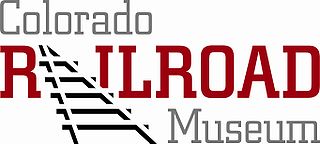
The Colorado Railroad Museum is a non-profit railroad museum. The museum is located on 15 acres (6.1 ha) at a point where Clear Creek flows between North and South Table Mountains in Golden, Colorado.

The Ghost Town & Calico Railroad is a 3 ft narrow gauge heritage railroad within Knott's Berry Farm, a theme park in Buena Park, California.

The John Hay Center is on the eastern edge of the Salem Downtown Historic District in Salem, Indiana. It comprises:
The Shavano was a named passenger train operated by the Denver & Rio Grande Western Railroad between Salida and Gunnison, Colorado. The train, named for nearby Mount Shavano, operated over the railroad's historic narrow gauge route over Marshall Pass. The Shavano operated as Train #315 westbound, and #316 eastbound.

The Rio Grande Scenic Railroad of Colorado, a heritage railway, began operations in 2006, operating both steam and diesel locomotives in and around the San Luis Valley, on trackage of the San Luis and Rio Grande Railroad. Located 200 miles (320 km) south of Denver, Colorado, the Rio Grande Scenic Railroad operates out of Alamosa, Monte Vista and La Veta. This 4 ft 8 1⁄2 instandard gauge route, featuring a climb over the Sangre de Cristo Mountains via Veta Pass, dates back to 1899 and is a successor to the original 3 ft narrow gauge La Veta Pass line of the Denver and Rio Grande Railway, completed in 1878. In keeping with the Denver and Rio Grande Western slogan Scenic Line of the World, the trip between Alamosa and La Veta offers views of several of Colorado’s 14,000-foot (4,300 m) peaks.
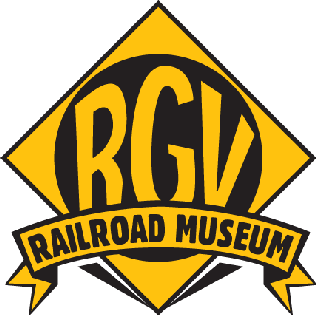
The Rochester and Genesee Valley Railroad Museum (RGVRRM) is an operating railroad museum located in Industry, New York. The museum started in 1971 with the purchase of a former Erie Railroad Depot from the Erie Lackawanna Railroad. Since then the museum has grown to include a one-mile demonstration railroad, making it one of the only operating railroad museums in New York State. The museum was formerly an operation of the Rochester Chapter National Railway Historical Society until 2011. The organization rosters more than 40 pieces of historic railroad equipment, including diesel and steam locomotives, electric trolley and multiple-unit cars, freight cars, cabooses, passenger cars, and work equipment. The museum campus includes a number of preserved railroad structures, including the 1909 Industry Depot built by the Erie Railroad, a waiting shelter from the Rochester, Lockport & Buffalo Railroad, and a crossing watchman's shanty from the New York Central. Train rides are operated and the museum is open to the public on select weekends from June through October, and is staffed entirely by volunteers.

Chicago, Milwaukee, St. Paul and Pacific Depot – Delmar is a historic building located in Delmar, Iowa, United States. It is listed on the National Register of Historic Places.

The South Torrington Union Pacific Depot was built in 1926 just to the south of Torrington, Wyoming. It was designed by Gilbert Stanley Underwood in the Mission Revival and Spanish Colonial Revival as a combined passenger and freight depot.

The Alberta Central Railway Museum is a railway museum located south-east of the City of Wetaskiwin, in Central Alberta, Canada. The main building was designed as a scaled-down version of the City's 1907 Canadian Pacific Railway depot. The depot includes a waiting room, baggage room and telegraph office, as well as exhibits and railroad artifacts. Railroad equipment includes locomotives, a sleeper car, passenger coach, freight equipment, cabooses, freight cars and a snowplough. Attractions include a model train layout of the original Wetaskiwin railyard. The museum also features a 1906 Alberta Grain Co. grain elevator which was moved from Hobbema. The elevator is known to be Alberta's second-oldest grain elevator in the Province. Rides are given on a one-mile loop of track.
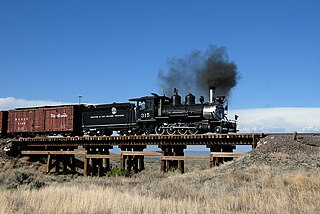
Denver and Rio Grande Western No. 315 is a Class C-18 2-8-0, Consolidation type, narrow gauge steam railway locomotive that was originally built for the Florence and Cripple Creek Railroad by Baldwin Locomotive Works in 1868. On the F&CC it was number 3, named Elkton. After the demise of the F&CC in 1915, the locomotive sat unused until the Denver & Rio Grande purchased it and four of its sisters in 1917 to help with war traffic. In D&RG service it became No. 424, but was renumbered No. 315 when the D&RG became the Denver and Rio Grande Western in the reorganization of 1924. It began its D&RG service at Alamosa, Colorado, was leased to the Rio Grande Southern for 1926-27 and then spent most of the next decade on the Gunnison Division, in Salida, Colorado, on the line to Montrose and on the branch to Ouray.

Denver and Rio Grande Western No. 168 is a 4-6-0, Ten Wheeler type, narrow gauge steam railway locomotive. It is one of twelve similar locomotives built for the Denver and Rio Grande Railroad by Baldwin Locomotive Works in 1883. It was built as a passenger locomotive, with 46 in (1,200 mm) drivers, the largest drivers used on any three foot gauge D&RGW locomotive. The large drivers made it suitable for relatively fast passenger service.
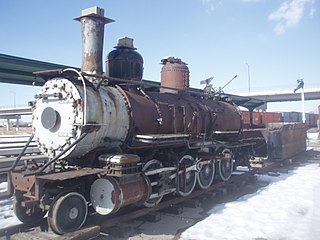
Denver and Rio Grande Western 223 is one of a class of 28 2-8-0, Consolidation type, narrow gauge steam railway locomotives built for the Denver and Rio Grande Railroad by the Grant Locomotive Works of Paterson, New Jersey in 1881-82. Number 223 was completed in December 1881, at a cost of $11,553. Baldwin built an additional 25 locomotives in the same class at the same time.

The Railroad Museum of Oklahoma is a railroad museum located in the former Atchison Topeka and Santa Fe freight depot in Enid, Oklahoma. The museum began in 1977 and is a non-profit operated by the Enid chapter of the National Railway Historical Society. The freight depot was listed on the National Register of Historic Places in 2015.
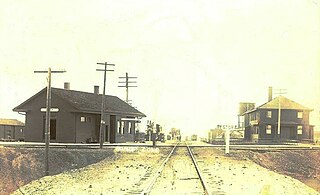
Limon Railroad Depot was a major Union Pacific and Chicago, Rock Island and Pacific Railroad station in Limon, Colorado. It has been on the National Register of Historical Places since 2003. It is included in what is now the Limon Heritage Museum and Railroad Park. It is one of seven still standing Rock Island Line stations in Colorado, and the only one restored.

The Denver and Rio Grande Western Depot, commonly referred to as the Rio Grande Depot, is a former train station on the western edge of downtown Salt Lake City, Utah, United States. It is currently home to the Division of Utah State History and the Utah Department of Heritage & Arts, as well as the Rio Gallery.

The Central of Georgia Depot in Andalusia, Alabama is a historic train station that has been converted into the Three Notch Museum.



